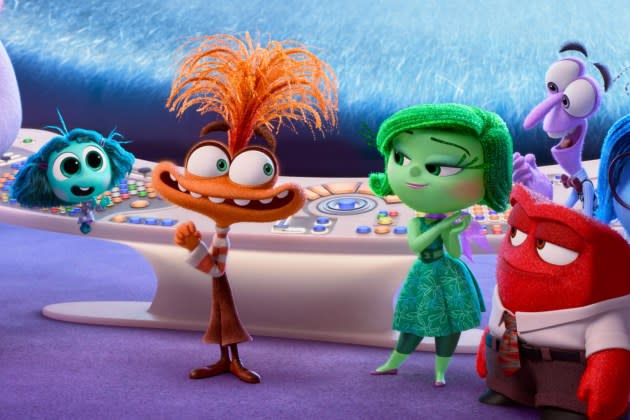Amy Poehler, Maya Hawke and ‘Inside Out 2′ Filmmakers Talk Pulling Off the Climatic Anxiety Attack Sequence Which Required ’25 Meetings’ to Plan For

SPOILER ALERT: This story discusses major plot points, including the ending for “Inside Out 2” now playing in theaters.
“Inside Out 2” director Kelsey Mann and producer Mark Nielsen held “a good 25 meetings” in preparation for the film’s climactic scene — when Riley, the movie’s teenage protagonist, suffers an anxiety attack. But these weren’t any average production discussions, they were “the gatherings of the mind council,” which summoned all the department heads together to strategize the execution of the scene.
More from Variety
'Inside Out 2' Shatters Box Office Expectations With $155 Million, Biggest Debut Since 'Barbie'
Box Office: 'Inside Out 2' Jumps for Joy With $62 Million Opening Day - the Biggest of 2024
Box Office: 'Inside Out 2' Launches to $13 Million in Previews, the Most of Any 2024 Movie
“Simulation, effects, lighting and animation all together like, “‘How are we going to do this?'” Neilsen tells Variety.
“We had a gong our visual effects supervisor [Sudeep Rangaswamy] would ring at the beginning and end of every meeting,” Mann adds. “It was a collection of all the heads of the different departments to figure out the difficult things.”
“Inside Out 2” follows a now 13-year-old Riley who must grapple with a new set of overbearing emotions while staying at a sleepaway hockey camp — with the most controlling emotion of all being Anxiety (voiced by Maya Hawke). In the film’s third act, Riley’s nerves bubble over when her coach banishes her to the penalty box during her final scrimmage. Inside her head, a tornado of anxiety forms around the central controls, while in the real world, Riley breaks down into a panic.
Because the film was produced “more or less in show order,” the anxiety attack scene was tackled toward the end of the production schedule. With a hard deadline on the horizon, the Pixar team needed to hustle up if they wanted to make the June 2024 release date.
“You want to make sure that it feels real and authentic,” Mann says. “To come up with a look that achieves that is really hard. It took lots of different departments all working collaboratively in order to pull that off. We also did it right at the end. Time was running out.”
Two department heads critical in achieving the scene’s authenticity were co-cinematographers Jonathan Pytko and Adam Habib. Because of the time constraints, the ending sequence was “coming in hot,” requiring Pytko and Habib to operate “on the fly” without storyboards. However, considering the importance of the moment, the pair had “a lot of conversations” throughout production about how they wanted the anxiety attack to look.
“We started doing a lot of things like tightening up the shutter angle, so, suddenly, everything’s a lot sharper and the focus got a lot deeper as Riley’s putting more and more pressure on herself,” Habib explains. “Then, when the anxiety attack hits, suddenly we flip everything. The focus goes extremely shallow and the world drops away.”
Adds Pytko: “That moment in particular was interesting because we had talked about, what if we start vibrating the background as Riley gets deeper into this panic attack? We overexposed the light a lot and really flooded this light coming around Riley as she’s going through this moment. Then adding that [vibration] in there really sold what happened.”
As “a person who has had an anxiety attack,” Hawke brought that personal experience to her voice performance. When it came time to shoot the scene, she focused on her breathing to capture the feeling of panic.
“Your breath moves to a different place and you can’t breathe as deeply as you want to,” Hawke says, explaining that she worked with filmmakers to determine the right amount of breath to use to portray Anxiety’s spiral. “I saw it as the air not going down into her breath. It was like a tornado, and you can’t breathe when you’re stuck in the middle of a tornado.”
Amy Poehler, who voices Joy, described the moment as “painful” for her character, who tries to calm Anxiety down as the mother figure of the emotions. As a mother to two teenage boys, Poehler related to Joy’s struggle to help despite not having the answers.
“That’s a hard thing, when you’re a parent and you don’t know what to do when you’re trying to help your child. If Riley is Joy’s kid, then Joy is kind of like ‘What’s happened to my kid?'” Poehler says. “Pixar is so smart to have Joy take her foot off the gas, and by doing so, and not pushing so hard, Riley just soothes herself, which is the hard lesson of growing up.”
Additional reporting by Jazz Tangcay.
Best of Variety
Sign up for Variety’s Newsletter. For the latest news, follow us on Facebook, Twitter, and Instagram.

